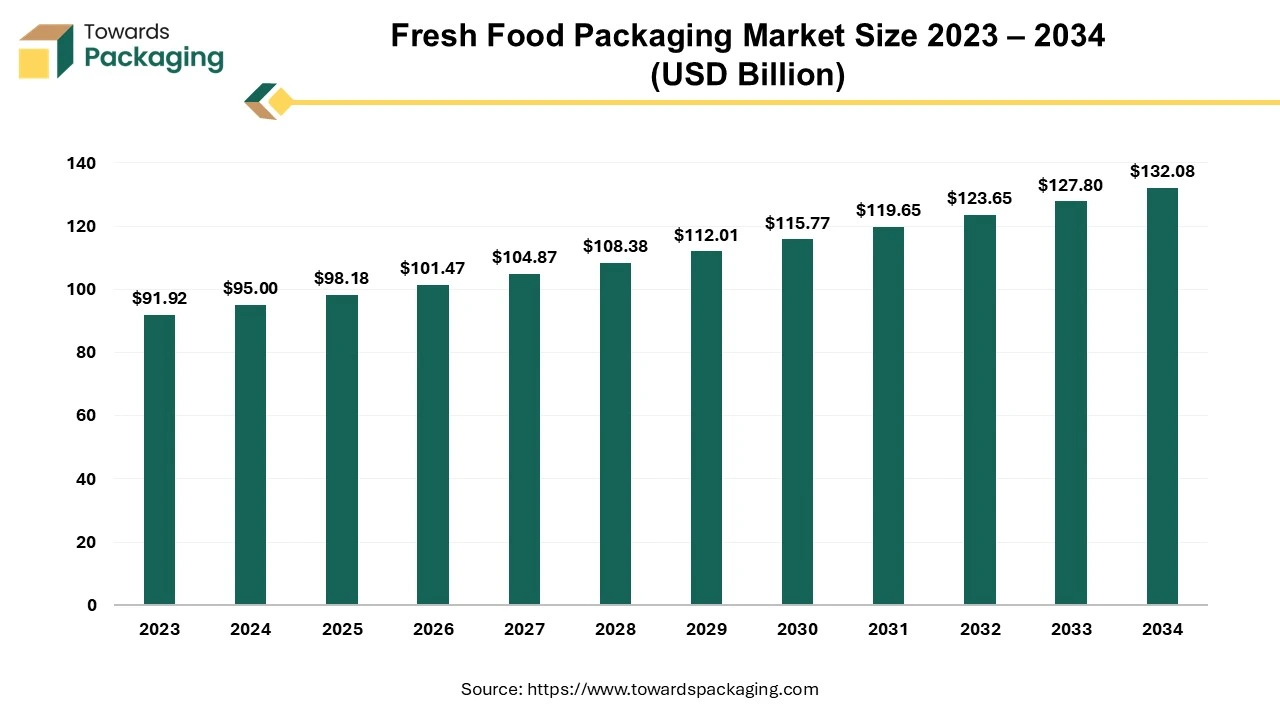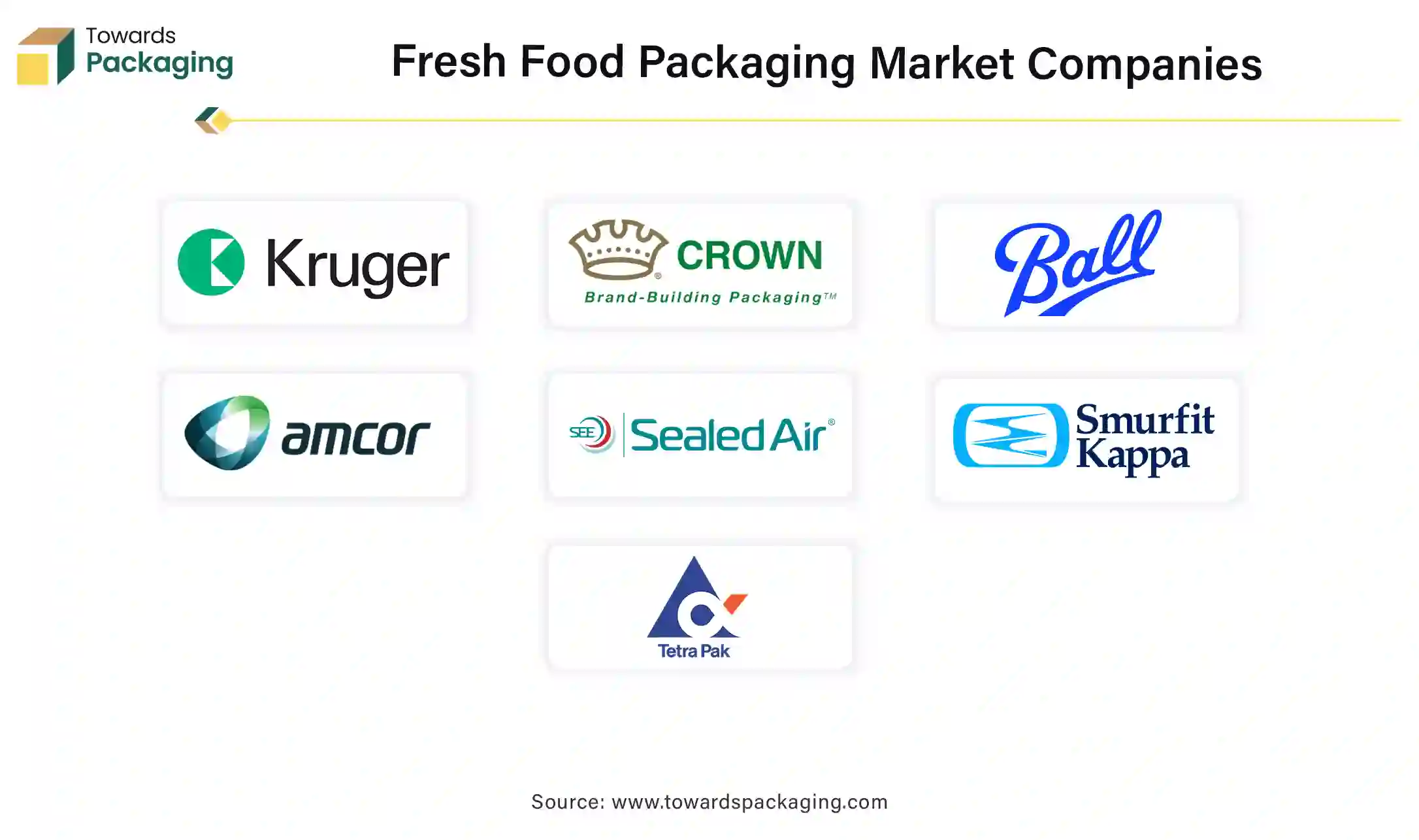April 2025
The fresh food packaging market is valued at USD 95 billion in 2024 and is expected to reach USD 132.08 billion by 2034, growing at a CAGR of 3.35% from 2025 to 2034. This steady expansion is driven by increasing demand for sustainable and efficient packaging solutions worldwide.

The market is observed to grow due to the rising demand for convenience food items availability and to extend the shelf-life period of the food by premium packaging.
The fresh food packaging market is growing significantly due to the advanced packaging systems available. The rising tendency to eat healthy food has raised the concern for convenient, sustainable, and safe packaging. The major focus is to pack food to protect the quality of the food for a longer period and provide convenience to the consumers. This market contains a wide range of materials to manufacture suitable packaging products such as glass, plastic, paper, and various other biodegradable options. Rising concern for manufacturing eco-friendly products has raised the development of these packaging. The major factor behind the growth of this market is the increasing preference for fresh packaged foods, mainly in this changing lifestyle and rising awareness about the health and wellness of people.
AI-integrated packaging technologies play an important part in increasing the shelf life of fresh food items, eventually helping to decrease food waste. These advanced solutions use sensors for monitoring the humidity, temperature, and other aspects to guarantee ideal food protection. Market players incorporating AI in the packaging industry to improve food safety majors and widely contribute to decreasing the environmental impact of waste food. Through active alterations to packing conditions, AI incorporation increases product durability and reduces food waste, suitable for achieving sustainability goals.
Artificial intelligence incorporation permits continuous observation of food products, confirming quality regulators and freshness preservation. By leveraging advanced AI packaging with real-time monitoring facilities, the technology can promptly sense any aberrations in the condition of the food, thus increasing its shelf life and decreasing waste suggestively. These AI-incorporated systems decrease food waste and increase food safety by giving biological and chemical safety.
Customers nowadays are highly concerned regarding their eating choices which makes them conscious of the products they purchase and their packaging. Due to the growing number of working people the demand for packaged and ready-to-eat food increasing rapidly ultimately influencing the demand for longer shelf life of food products. The demand for improved food packaging rising to maintain the nutritional value and freshness of food products.
Technological developments in packing materials and procedures are also contributing to the development of the market. Revolutions such as MAP (modified atmosphere packaging), vacuum skin wrapping, and dynamic packaging are improving the defence of fresh food products. These technologies support decreasing food leftovers by delaying the decay procedure, thus providing an extended shelf life and preserving product freshness.
An important trend boosting the growth of the fresh food packaging market is sustainability. With rising awareness about environmental issues and plastic contamination, there is a growing demand for environment-friendly packaging techniques. Major market players are advancing compostable, recyclable, and biodegradable materials to fulfil customer expectations and supervisory necessities. Sustainable packaging solutions decrease the carbon footprint and increase brand identity and customer constancy.
Smart packaging technology is transforming the fresh food packaging market. These advanced solutions integrate sensors and pointers that help to observe the condition of the food by maintaining factors such as humidity, temperature, and freshness levels. Smart packaging safeguards the taste and quality of fresh food but also offers appreciated data to both customers and producers. For example, time-temperature indicators can aware customers if a food item has been uncovered to extreme temperatures, thus stopping foodborne diseases.
Personalized packaging techniques are increasing demand in the market, fulfilling certain requirements and likings of separate customers. Personalized packaging strategies, small packaging, and other packaging that accommodates eating limitations are becoming more popular. Customization increases customer practice but also decreases food waste by delivering suitable-sized servings.
Continuous fluctuation in packaged fresh food harms the growth of the market. It has been hampered due to the changing rate of food products. Due to such fluctuation market players suffer huge losses sometimes that hinder growth. The unavailability of certain food products also hinders the growth of the market due to the off-season sometimes.
The plastic segment is leading in fresh food packaging as these are found to be cost-effective solutions. Its affordability permits extensive use, providing industries and customers with a budget-friendly solution that doesn’t negotiate on excellence or functionality. Plastic fresh food packaging is well-known for its durability, which confirms that foods are kept protected. Extended shelf life and transport safety can help protect food from perishability. The correct packaging can restrict damage and decrease the quantity of food waste. Plastic packaging is easy to print designs. It enhances the brand visibility by easily displaying products across all their fresh food items if packaged in easily-printable plastic containers.
Vaccum skin packaging has influenced the fresh food packaging market by technological type. It can enhance the shelf life of fresh food, maintain the quality of the food, and improve the appearance of the food. This slows down the decaying, oxygen acquaintance, and microorganism growth in the food products. One of the major reasons for the growing demand for vaccum skin packaging is it helps to protect the texture and colour of food. It is an expensive side than any other packaging process due to its procedure but due to the quality it provides majority of people choose this type of packaging with growing health and wellness awareness.
Rigid fresh food packaging can be available in any shape and size in the market which influences the demand for this. It can fit products perfectly in containers and preserve the nutritional value of the food items. This type of packaging is preferred to transport products to a longer distance without any damage. These are highly durable, and strong, and do not damage easily due to any hindrance while travelling. Rigid packaging is adopted to pack fruits, dry fruits, vegetables, meat, dietary products, and ready-to-eat food packaging. It provides top-quality protection to avoid any contamination due to the effect of light, moisture, air, and various other reasons.
The packaging market plays a vital role in shipping food to different places which requires the safety of food. These shippers are extensively used for bulk product packaging and protect food products from any kind of damage while transporting. This kind of packaging is important for wrapping and transporting food items such as dairy, frozen products, fresh products, meats, and a wide range of food items to deliver by regulating temperature to avoid any kind of damage at any adverse condition.
Rising demand for online ordering of grocery products has enlarged the food shipper segment extensively. As the demand for fresh and high-quality products is growing among customers so majority of brands prefer to use them. With the rise of global trade, major market players prefer food shippers to transport products due to advanced technology incorporation and the capacity to regulate temperature to keep food products safe.
Asia Pacific witnessed the highest revenue share for the year 2024 this growth is due to rising urbanization, growing disposable earnings, changing lifestyles, and rapid growth in the demand for freshly packaged food. The developing economic condition of people in countries such as India, Japan, China, South Korea, and Thailand growing demand for ready-to-eat food. The major shift towards cities and working couples led to a lack of time and a rising number of e-commerce platforms has significantly improved the fresh food packaging market. The vacuum skin packaging (VSP) and modified atmosphere packaging (MAP) enhanced the food preservation quality of food.
North America is estimated to grow at the fastest rate over the forecast period. The growing demand for premium and convenient packaging of food products with strict regulation towards the packaging industry has influenced the fresh food packaging market significantly. This region is well-developed and the working population is growing rapidly resulting in a rising demand for fresh food packaging with advanced technology. In countries such as the U.S. and Canada, there is a huge rise in demand for sustainable packaging of a wide range of products and strict government regulations for packaging companies have influenced the market development.

By Material Type
By Technology
By Packaging Format
By End Use
By Region
April 2025
April 2025
April 2025
April 2025